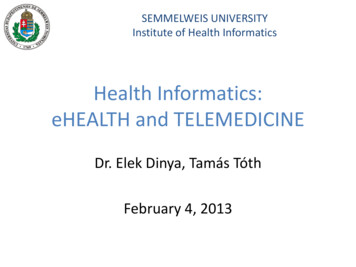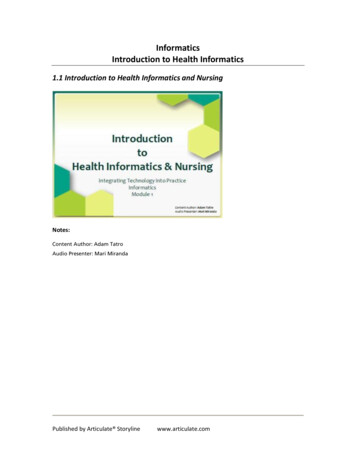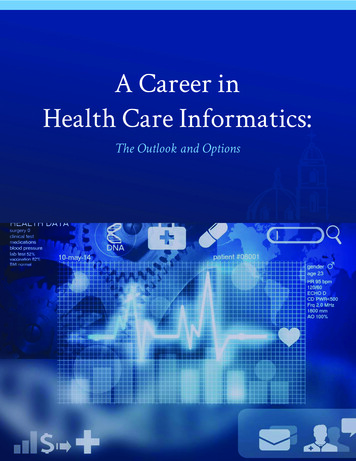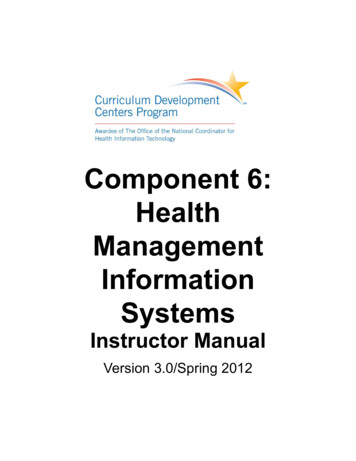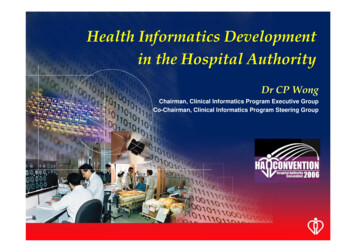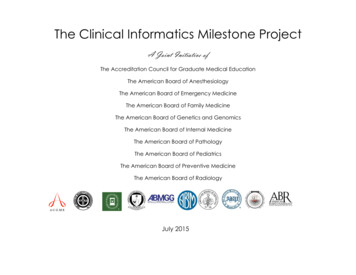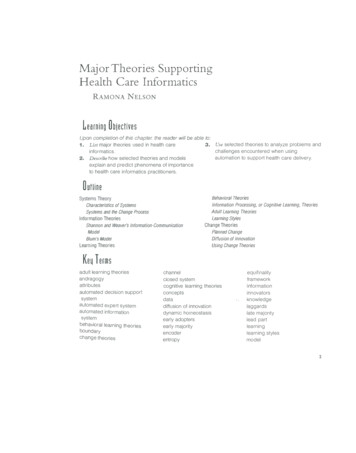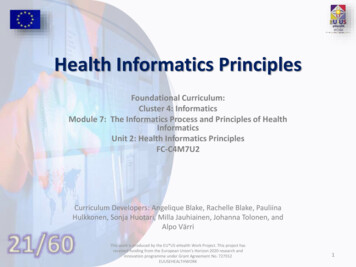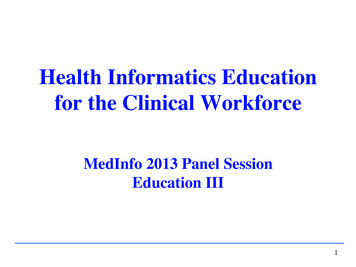
Transcription
Health Informatics Education for the Clinical Workforce MedInfo 2013 Panel Session Education III1
Panel Presentersv Anthony Maeder, Australiav Kathleen Gray, Australiav Kendall Ho, Canadav Edward Shortliffe, USAv Paul Taylor, UKv Maurice Mars, South Africa2
Motivationv Health Informatics education driven by HI curriculum designv Variable extent of coverage within Clinical qualifying coursesv Varying nature of recognition and regulation of HI knowledgev Little on issues of delivery methods, assessment, scaffolding.3
Outlinev Major study undertaken on Australian circumstancesv Examples of “state of play” in some other national settingsv Discussion on issues and directions for further considerationv Anecdotal contributions from audience on other experiences4
Discussionv Appropriate coverage, depth, methods etc for clinical coursesv Examples of success and failure aspects from case studiesv Approaches for motivating and introducing HI componentsv Further (international) initiatives or opportunities5
eUniversityofMelbourne
rac(ceWaysforward2
1. Contextandchallenges TheAustralianscene 3slidesaboutourproject3
Australia’sLocal&GlobalEhealthConcerns ucture,PCEHR,telehealth,e- ‐prescribing,[clinicallead] s,publichealth,someprimaryandcommunitycare e biomedicalR&D ehealthITindustry e,studentpopula(on,globalisa(onofhealthcare/IT4
dencourage:– curriculumrenewalforehealthcapability– inclinicalhealthprofessionaldegrees– throughacoordinatedinterprofessionalapproach4- ‐university,4- ‐Stateteam2010- ‐2013:KathleenGray&AmbicaDa tyofWesternSydneyKerrynButler- (onchampions.
skillsanda ributestouseICTseffec(velyinhealthcare? earningalone. ma(cs. illscurricula.6
ce: ,alliedhealth,complementarytherapies ctorWithreferencetoothersdoingrelatedwork,e.g. itsmembers(ACHI,ACS,HIMAA,HISA,HL7A) edicalInforma(csEduca(onWorkingGroup7
seduca(oncomesfromtheseprojectac(vi(es: Literaturereview Degreecoordinatorsurvey&interviews Interprofessionalworkshops8
WhatwewantedfromtheliteratureEvidencefrompeer- ma(cseduca(on,regarding:– � teachingmethodsandmodesofdelivery?– techniquesforassessmentofstudentlearning?– a ainmentofintendedlearningoutcomes?– standardisa(onandaccredita(onofcurriculum?– educa(onalqualityimprovementprocesses?9
Whatwefoundintheliterature Ashortlistofaround20papersinthepeer- inEnglishbetweentheyears2000- l/healthinforma(cstofutureclinicians. allyvalidatedinstrumentsorprocesses. alua(on.Details:Da uropeanJournalofBiomedicalInforma3cs,2011.10
entsofhealthsciencesinthree- ‐quartersofAustralianuniversi(esWhatma inthedegreeforwhichyouareresponsible?S11
ca(onisnotsystema(cnorwidespread. 25%- - ‐centredness tEHRs. Misconcep(onse.g.ehealth elearning.Details:Da akumar,A.,Gray,K.,Butler- ralianstudy.InMaeder,A.J.andMar(n- am,Netherlands,pp.33- ‐39.12
lysed,reported.13
cieswererecognised:– �� Accountabilityforinforma(onethicsandsecurity– � Evidence- ‐basedadop(onofICTsinhealthcare torawareness.14
fromprojectinves(ga(onsinto: Learningresources Accredita(onguidelines Employerrequirements15
Canweleverageexis(nglearningresources? - ‐for- ‐profits Inventoryof100rela(velyopenandreputableresources What’smissing: rienta(on ent ANDwidelyavailableconvenientCPDforeducators16
Canweleveragedegreeaccredita(onguidelines? idelines forma(csThemissinglink: ronichealthrecords’once;‘informa(cs’twice ��informa(on’,‘technology’–some(mes. BUTjustasoventheinferenceistoelearningfacili(es. Informa(csrelatedtermsovenarenotclearlydefined. degree(re)accredita(onhappensevery3- ‐5years
? n2012 informa(csknowledge,skills,a ributessoughtbyemployersMissinginac(on: Theword‘ehealth’neverappeared. uldbeconstruedasrelevant- ‐mostcommonly‘computerliterate’. Suchcriterialistedasdesirableasovenasessen(al. uely. 8
4.Wheretofromhere,maybeinmylife(me?19
Recentdevelopments abilityResource,provisionaledi(onMarch2013- ‐associatedehealthtoolsarepromised. July2013- etencies? Workgoingonwithinseparateclinicalprofessions- ��t?20
Leadershipandcollabora(on ssessmentresources sandstudentsupervisors employerorganisa(ons a(onandcer(fica(onframeworks Focusonpolicy- ehealthstrategy. cebase!21
Thanksforyoura en(on!Comments/Ques(ons/Follow- ‐upProjectwebsiteh ray@unimelb.edu.au22
MedInfo2013CopenhagenAugust21,2013HealthInforma csEduca ce
3daysinParis“Addonemoresite?”
HI Training for health urriculum?eHealthStrategyOffice
UBCFacultyofMedicineHITraining: Currentintegra4on CurriculumrenewalCanadianHITraining: MedSchools/Residency Healthprofessionals
g&surveillance,P.M.
EMRLearningPlaLorm(1week)Tele- ‐Psychiatry(7weeks) 3rdyearmedicalstudentsBACKPAIN DIABETESVideoconferenceinterview:pRECOVERYa4ents SupervisedDIbypsychiatrymPost- dica4onuse re- schargeseum.HealthStrategyOffice
UBCCurriculumRenewal2014 ealthStrategyOffice
Na onalHITrainingStrategy:CanMEDS* Associa onsofFacul esofMedicineeHealthEduca4onCommiTee RoyalCollegeeHealthExpertWorkingGroup choolgraduateMid- ‐residencyGradua ngresidentPrac eonsofCanada
Pa entCentredCare:Inter- EHRtraininginCanada”–a2014reporttoHealthCanada
HITraining:Evalua ngProgressTimeü ü ü ü ��usion/dissemina4onAccomplishdes4na4ongoalsGoals BC, National, Global:Clinician engagementEHR trainingBenefits evaluation HHR Competencies
Timing is everything!!
It’sTime:eHITraining xchangeNa4onalGlobaleHealthStrategyOffice
UBCFacultyofMedicineeHealthStrategyOffice Internet:Facebook:TwiTer:E- hStrategyOffice@ehealthstrategyKendall.Ho@ubc.ca 1.604.875.4111x69153eHealthStrategyOffice
Bringing Informatics intoClinical PracticeEdward H. Shortliffe, MD, PhDProfessor of Biomedical Informatics, Arizona State UniversityAdjunct Professor of Biomedical Informatics, Columbia UniversityAdjunct Professor of Public Health, Weill Cornell College of MedicineScholar in Residence, New York Academy of MedicinePanel on Education III Health informatics Education for theClinical WorkforceMedinfo2013, Copenhagen, DenmarkAugust 21, 2013
Making the Case for Informaticsin Medical EducationJAMA, February 23, 1990—Vol 264, No. 8 1114-1120!
Making the Case for Informaticsin Medical EducationJAMA, April 5, 1995—Vol 273, No. 13 1061, 1064-5!
Making the Case for Informaticsin Medical EducationJAMA, September 15, 2010—Vol 304, No. 11 1227-8!
Acronyms to Remember AMIA American Medical Informatics Association CMSS Council of Medical Specialty Societies ABPM American Board of Preventive Medicine ABMS American Board of Medical Specialties ACGME Accreditation Council for GraduateMedical Education RRC Residency Review Committee MOC Maintenance of Certification
CI Subspecialty timeline 2004 AMIA calls for training 6000physicians and 6000 nurses Later 10,000 10X10 program 2005 AMIA town meeting Growing interest in certificationnoted among health professionalsworking in clinical informatics
CI Subspecialty timeline 2007 RWJF grant to AMIA 2008 Core and Training documentscreated 2009 Core and Training documentspublished after AMIA Boardapproval
JAMIA 2009;16:153-157!
JAMIA 2009;16:158-166 !
CI Subspecialty timeline AMIA contacts boards to assessinterest in sponsoring newsubspecialty proposal 2009 ABPM Board Agrees toPropose CI as a subspecialty toABMS (works with AMIA to draftproposal and present it to theother specialty boards)
CI Subspecialty timeline 2010 Pathology joins PreventiveMedicine as a cosponsor 2011 ABPM and AMIA jointlypresent CI subspecialty proposalto ABMS subcommittee thatreviews all proposals for newsubspecialty certifications 2011 ABMS approves CI assubspecialty
CI Subspecialty timeline 2011 ABPM, as sponsoring board to oversee CIsubspecialty, begins process to create exam 2012 ABPM and AMIA begin planning forMaintenance of Certification (MOC) processthat will be in place by the time the firstdiplomats complete their certification in the CIsubspecialty Fall 2013 CI exam offered 2013 AMIA offers highly successful boardreview courses 2013 Accreditation body (ACGME) definescriteria for approving clinical fellowships in CI
Implications of These Developments Remarkable change in attitude and acceptanceof CI as a professional field Results in greater visibility and validation of CI Makes careers in CI more attractive tophysicians who are choosing their specialtyand subspecialty options Strengthens the core discipline and its appliedimplications May have positive influence on adoption ofinformatics topics throughout medical schoolcurriculum
Thank You!!ted@shortliffe.net!
HI In Clinical Curricula?Maurice MarsHead, Dept of TeleHealthUniversity of KwaZulúNatalSouth Africa
HI In Clinical Curricula?What are we trying to achieve?Why do we think this is necessary?Is it relevant?
What are we trying to achieve?AwarenessvsTrainingvsEducationGeneric vs contextual
The Problem25 sub-Saharan African countrieshave 10 Doctors or fewerper 100,000 peopleNot enough Doctors to train DoctorsWHO World Health Stats 2013
Countrywide, 56% of doctorposts are vacant and 46% ofnursing jobs unfilled.
The ProblemeHealth activities must not add extrasteps to the normal workflowof overburdened doctors and nursesNot enough Doctors to train DoctorsWHO World Health Stats 2013
10 StrategicPriorities
Priority 7: Capacity and Workforce“. involves developing career paths,training and skill retention strategies inorder to build up a workforce that caninnovate, develop, deploy, maintain andsupport all eHealth interventions, especiallyhealth information systems and healthmanagement information systems.”
Priority 7: Capacity and Workforce“Define a standardised eHealth competencyframework for health workers and health ITpractitioners providing an understanding ofrequired eHealth knowledge, skills andattributes for each professional group.”
Key Activity:Leverage partnerships and collaborationsfor Health Informatics trainingOutputs:Memoranda of Understanding (MoU)entered into with relevant institutions forpartnerships and collaborations for HealthInformatics training
What have we done?AwarenessvsTrainingvsEducation
What have we done?Capacity developmentIn health informaticsPostgraduate diplomaCoursework mastersPhDFogarty International Training Grant 100 students in 9 countries
HiBBs
The Way Forward?
AuthorPoint and Moodle
10 StrategicPriorities
What are we trying to achieve?AwarenessvsTrainingvsEducation
Introduction to Medical Information SystemsIntroduction to Electronic Medical RecordsTelemedicine: Planning and ManagementContemporary Topics in e-HealthProgrammingExperiential learningTele-educationE-Health ProjectmHealth and home monitoringPublic Health Management of medicalinformation systemseHealth Ethics and Law
Primer on medical information systemsDesign, implementation and evaluation of medicalinformation systemsSecurity for E-HealthResearch Methodology in E-HealthE-Health Research ProjectMedical Artificial IntelligenceIntroduction to biostatisticsBioinformaticsInternational eHealthProgramming Medical Informatics Systems
Health informatics Education for the Clinical Workforce Medinfo2013, Copenhagen, Denmark August 21, 2013 Bringing Informatics into Clinical Practice . Making the Case for Informatics in Medical Ed
